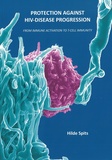Protection against HIV-disease progression
from immune activation to T-cell immunity

Spits, Hilde
- Promoter:
- Prof.dr. L. (Linde) Meyaard
- Co-promoter:
- Dr. J.A.M. (José) Borghans & dr. D. (Debbie) van Baarle
- Research group:
- Baarle , Inhibitory receptor lab , Borghans Tesselaar
- Date:
- October 8, 2015
- Time:
- 12:45 h
Summary
HIV infection undermines the immune system by causing a gradual loss of CD4+ T cells. Eventually, the weakened immune system is no longer able to offer resistance to opportunistic infections and the HIV-infected individual will develop AIDS. Even after 30 years of intensive research on HIV, there is still no proficient HIV vaccine. After the failure of the largest vaccine trial to date, in 2008, the need for a better understanding of the mechanisms controlling HIV infection has become painfully evident. In this thesis, we investigated 1) the cause of chronic immune activation during HIV infection and, 2) the characteristics of T-cell responses that provide protection against HIV-disease progression.
Activation - We show that the two main sources of body-wide immune activation that cause HIV disease progression stimulate different cell types. Both HIV-RNA and bacterial translocation contribute to the overall immune activation, but HIV-RNA mainly causes activation of CD8+ T-cells, while CD4+ T-cell activation seems primarily caused by bacterial translocation. We also investigated whether very early tempory treatment of HIV infection could prevent chronic immune activation. Despite a better prognosis of the early treated HIV-infected individuals, we found that early temporary therapy did not lead to reduced levels of immune activation after stop of treatment.
Protective T-cell responses – Although cytotoxic T-cell responses are widely held responsible for the control of HIV infection, CD8+ T-cell depletion in monkeys was shown to have no impact on the lifespan of infected cells producing virus. We hypothesized that because CTL responses that prevent HIV disease progression occur only in a small number of HIV-infected individuals, the effect of those protective CTL responses on the life span of HIV-infected cells may easily go unnoticed. To our surprise we found that even the most protective CTL responses do not shorten the life span of productively infected cells in vivo. For the development of a vaccine, we must therefore likely focus on T cells that recognize HIV-infected cells before they start to produce new viral particles, or on CD8+ T cells that act in a non-cytolytic way. When we studied the characteristics of the most protective CD8+ T cells in HIV-infected individuals, namely those that interact with one of the protective HLA molecules HLA-B27 or B57, we found that these T cells provide protection via completely different mechanisms, making it even more difficult to identify the characteristics of a protective CD8+ T-cell response.
The current challenge is to translate the fundamental steps that have been taken in identifying the sources of immune activation and the parameters of protective T-cell responses in HIV infection into better therapies that effectively reduce immune activation and lead to a working T-cell vaccine.